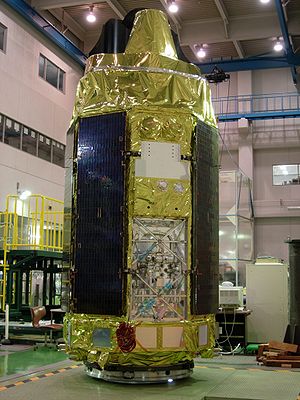 A picture of a fully integrated Astro-E2 before vibration tests at ISAS/JAXA. | |
| Names | ASTRO-EII |
|---|---|
| Mission type | Astronomy |
| Operator | JAXA / NASA |
| COSPAR ID | 2005-025A |
| SATCAT no. | 28773 |
| Website | www |
| Mission duration | 2 years (planned) 10 years 1 month 23 days (achieved) |
| Spacecraft properties | |
| Spacecraft type | ASTRO |
| Bus | ASTRO-E |
| Manufacturer | Toshiba[1] |
| Launch mass | 1,706 kg (3,761 lb) [2] |
| Dimensions | 2 metres x 5 metres |
| Power | 500 watts |
| Start of mission | |
| Launch date | 10 July 2005, 03:30:00 UTC |
| Rocket | M-V # 6 |
| Launch site | Uchinoura Space Center, Uchinoura, Kagoshima |
| End of mission | |
| Deactivated | 2 September 2015 |
| Decay date | No earlier than 2020 [3] |
| Orbital parameters | |
| Reference system | Geocentric orbit |
| Regime | Low Earth orbit |
| Perigee altitude | 550 km (340 mi) |
| Apogee altitude | 550 km (340 mi) |
| Inclination | 31° |
| Period | 96 minutes |
| Instruments | |
| X-ray Spectrometer-2 (XRS-2) X-ray Imaging Spectrometer (XIS) Hard X-ray Detector (HXD) | |
 The M-V launch vehicle carrying ASTRO-E veering off course after launch on 10 February 2000. | |
| Mission type | Astronomy |
|---|---|
| Operator | Institute of Space and Astronautical Science (ISAS) / NASA |
| COSPAR ID | 2005-025A |
| SATCAT no. | 28773 |
| Mission duration | Failed to orbit |
| Spacecraft properties | |
| Spacecraft type | ASTRO |
| Bus | ASTRO-E |
| Manufacturer | Toshiba |
| Launch mass | 1600 kg |
| Dimensions | 2 metres x 5 metres |
| Power | 500 watts |
| Start of mission | |
| Launch date | 10 February 2000, 01:30:00 UTC |
| Rocket | M-V # 4 |
| Launch site | Kagoshima Space Center |
| End of mission | |
| Decay date | Failed to orbit |
| Orbital parameters | |
| Reference system | Geocentric orbit (planned) |
| Regime | Low Earth orbit |
| Perigee altitude | 550 km (340 mi) |
| Apogee altitude | 550 km (340 mi) |
| Inclination | 31.0° |
| Period | 96.0 minutes |
| Instruments | |
| X-ray Spectrometer (XRS) X-ray Imaging Spectrometer (XIS) Hard X-ray Detector (HXD) X-ray Telescope (XRT) | |
Suzaku (formerly ASTRO-EII) was an X-ray astronomy satellite developed jointly by the Institute of Space and Aeronautical Science at JAXA and NASA's Goddard Space Flight Center to probe high-energy X-ray sources, such as supernova explosions, black holes and galactic clusters. It was launched on 10 July 2005 aboard the M-V launch vehicle on the M-V-6 mission. After its successful launch, the satellite was renamed Suzaku after the mythical Vermilion bird of the South.[4]
Just weeks after launch, on 29 July 2005, the first of a series of cooling system malfunctions occurred. These ultimately caused the entire reservoir of liquid helium to boil off into space by 8 August 2005. This effectively shut down the X-ray Spectrometer-2 (XRS-2), which was the spacecraft's primary instrument. The two other instruments, the X-ray Imaging Spectrometer (XIS) and the Hard X-ray Detector (HXD), were unaffected by the malfunction. As a result, another XRS was integrated into the Hitomi X-ray satellite, launched in 2016, which also was lost weeks after launch. A Hitomi successor, XRISM, launched on 7 September 2023, with an X-ray Spectrometer (Resolve) onboard as the primary instrument.
On 26 August 2015, JAXA announced that communications with Suzaku had been intermittent since 1 June 2015 and that the resumption of scientific operations would take a lot of work to accomplish, given the spacecraft's condition.[5] Mission operators decided to complete the mission imminently, as Suzaku had exceeded its design lifespan by eight years at this point. The mission came to an end on 2 September 2015, when JAXA commanded the radio transmitters on Suzaku to switch themselves off.[3][6]
Suzaku carried high spectroscopic resolution, very wide energy band instruments for detecting signals ranging from soft X-rays up to gamma-rays (0.3–600 keV). High-resolution spectroscopy and wide-band are essential factors in physically investigating high-energy astronomical phenomena, such as black holes and supernovas. One such feature, the K-line (x-ray), may be key to more direct imaging of black holes.
Suzaku discovered "fossil" light from a supernova remnant.[8]
Suzaku was a replacement for ASTRO-E, which was lost in a launch failure. The M-V launch vehicle on the M-V-4 mission launched on 10 February 2000 at 01:30:00 UTC. It experienced a failure of 1st stage engine nozzle 42 seconds into the launch, causing control system breakdown and underperformance.[9][10] Later stages could not compensate for underperformance, leaving payload in 250 miles (400 km) x 50 miles (80 km) orbit and subsequent reentry and crashed with its payload into the Indian Ocean.[11][12]